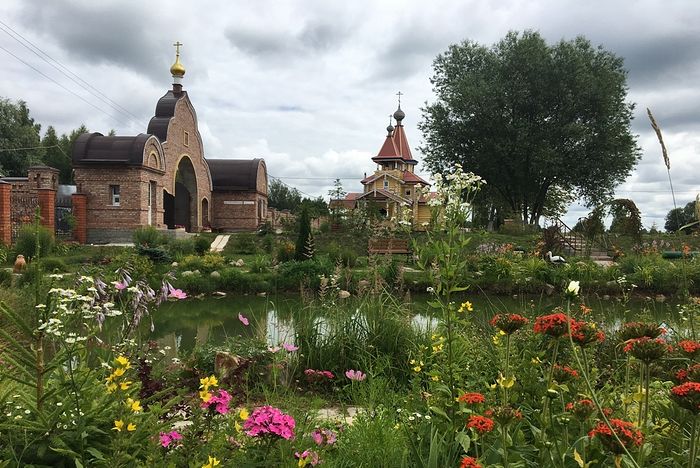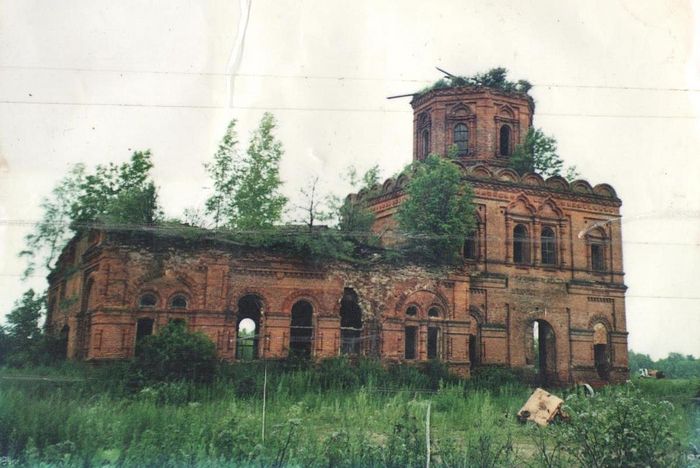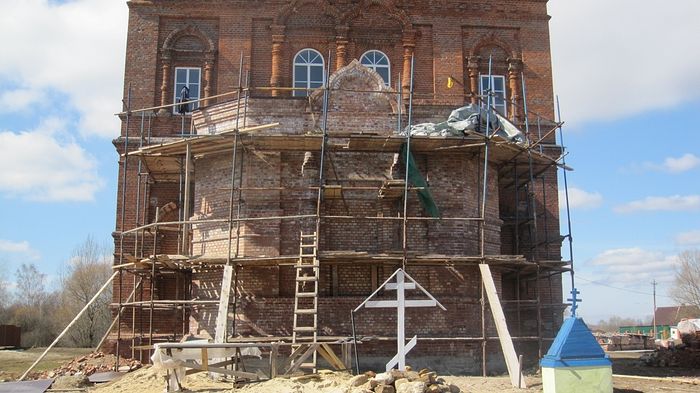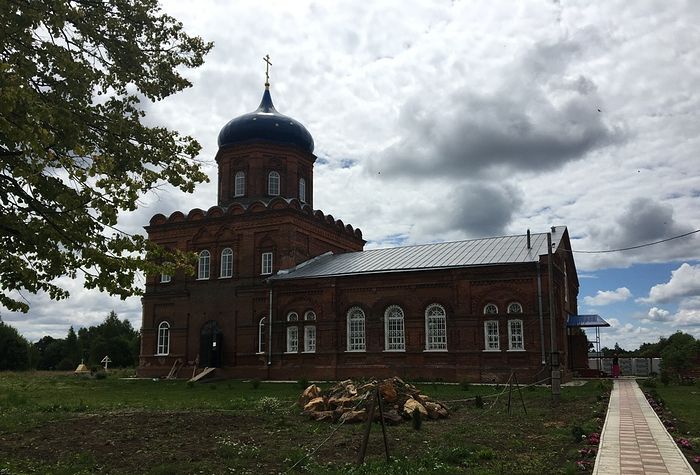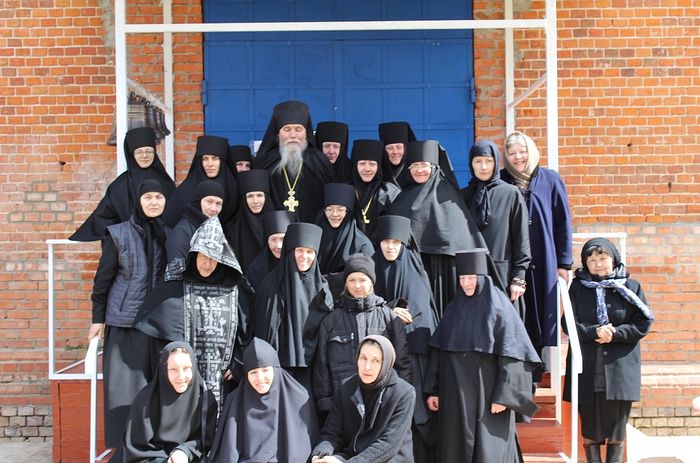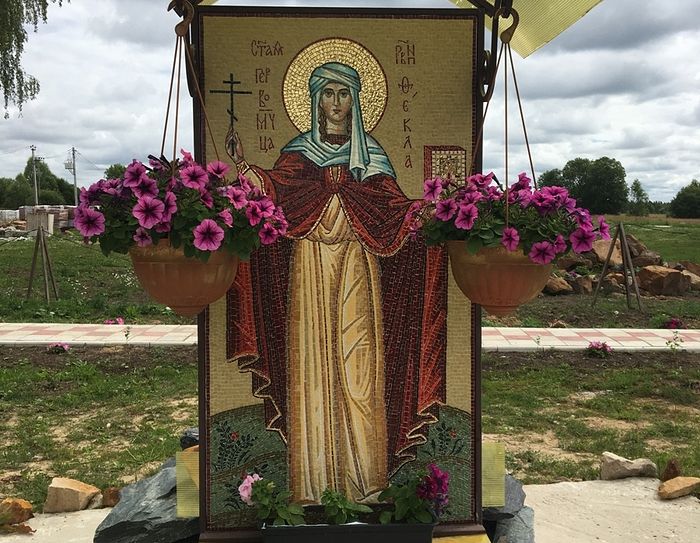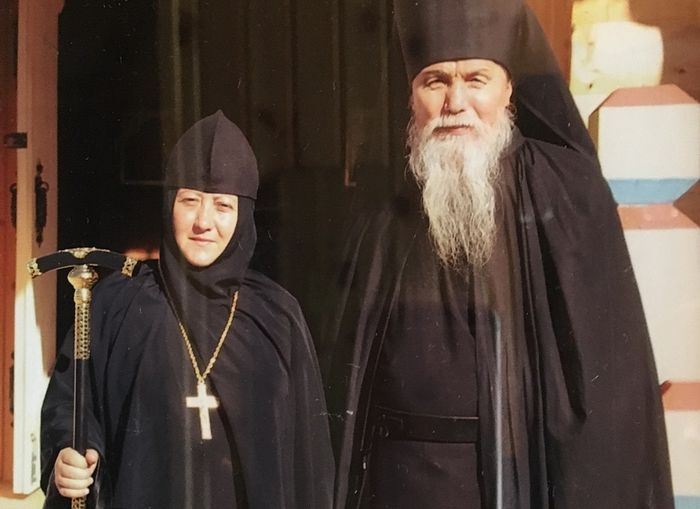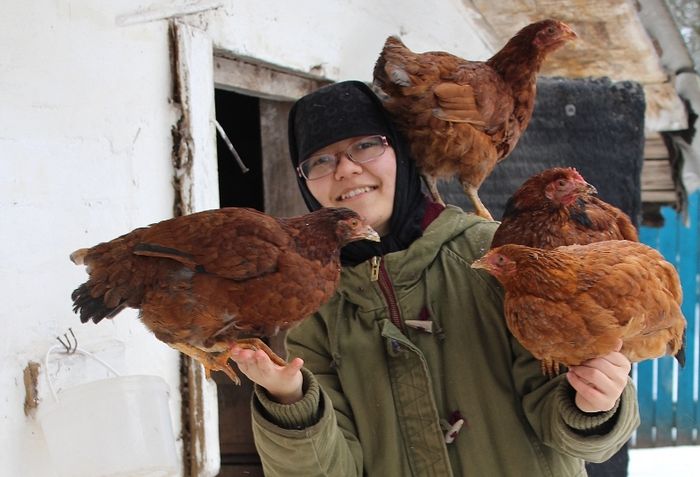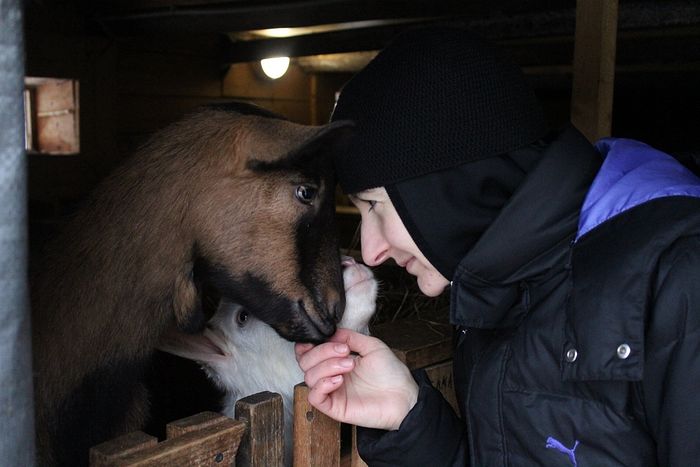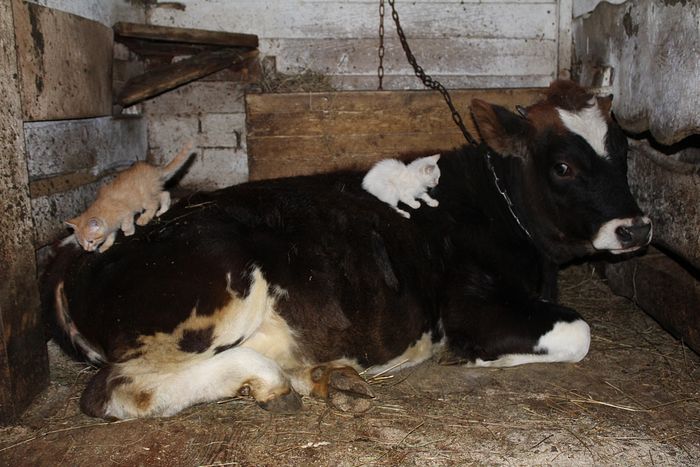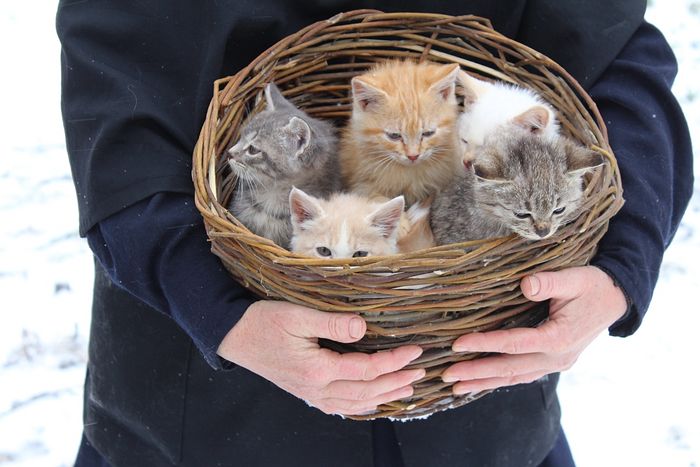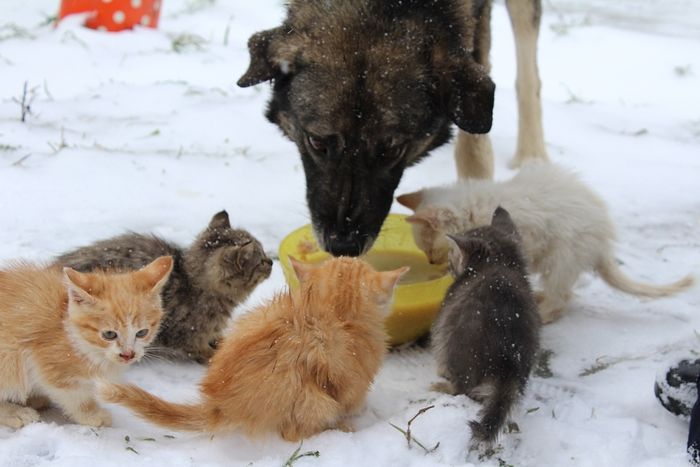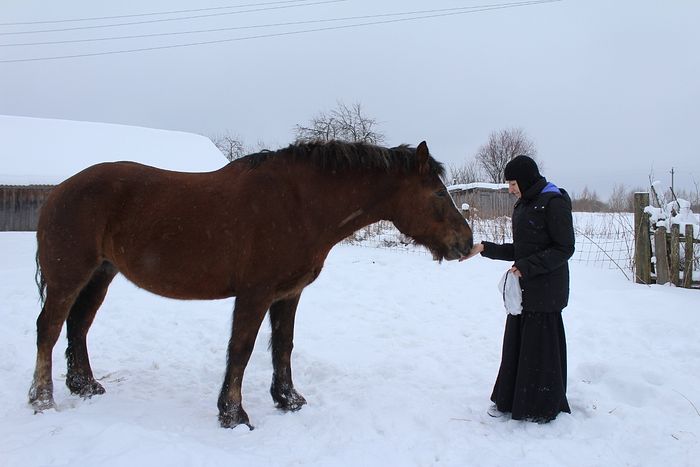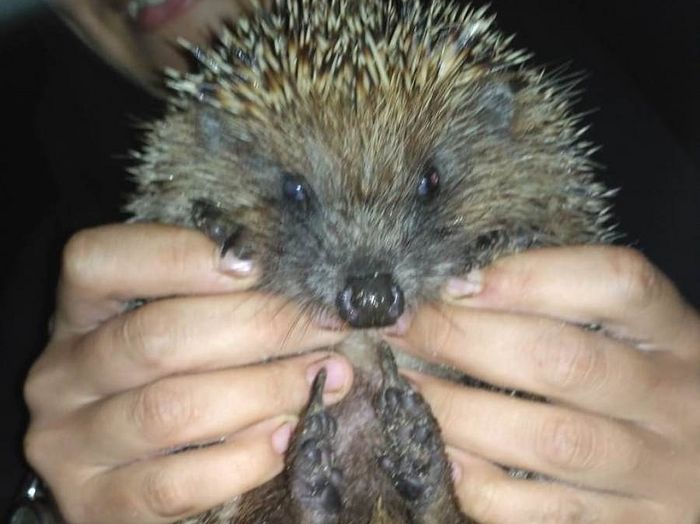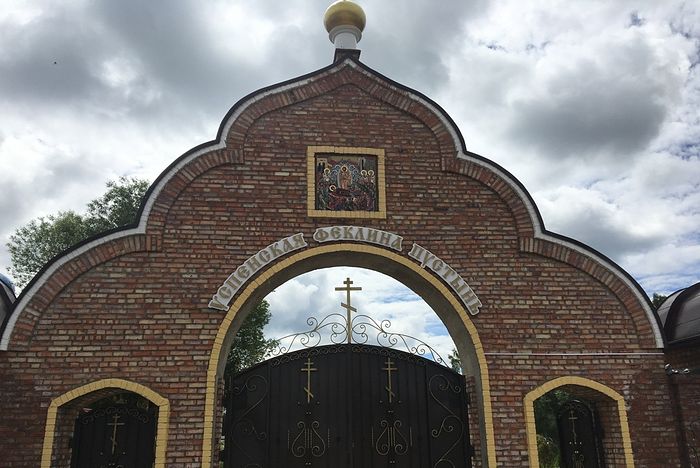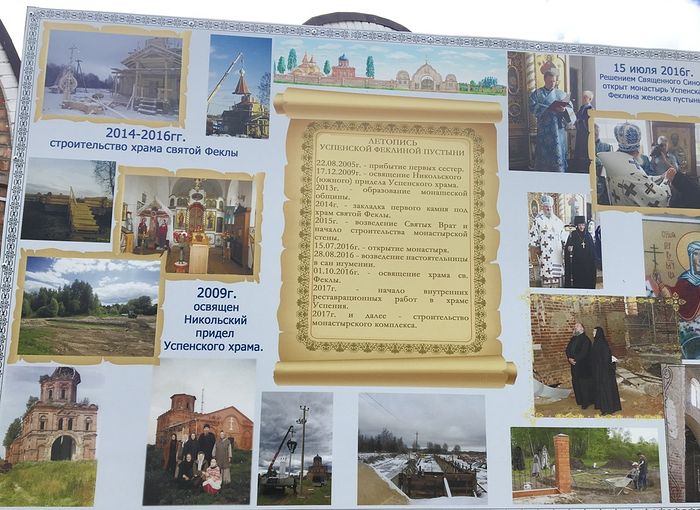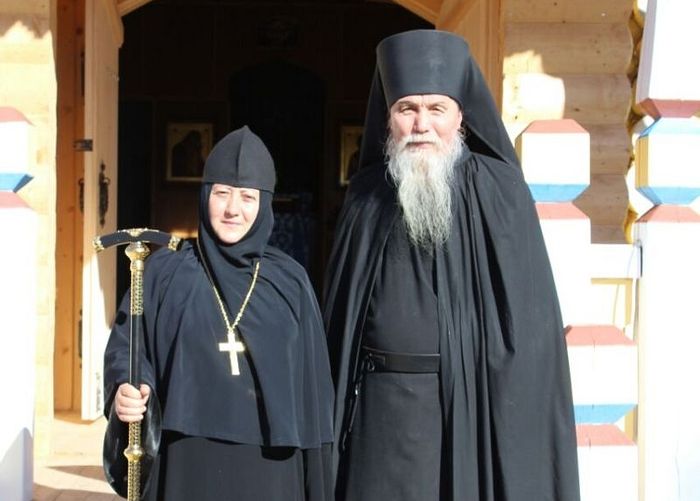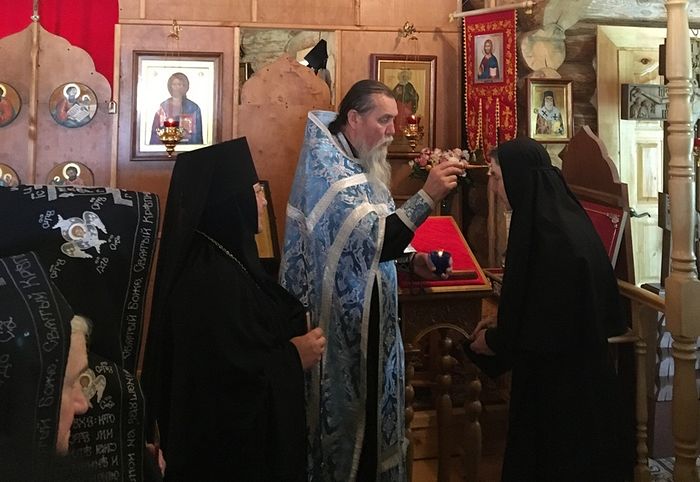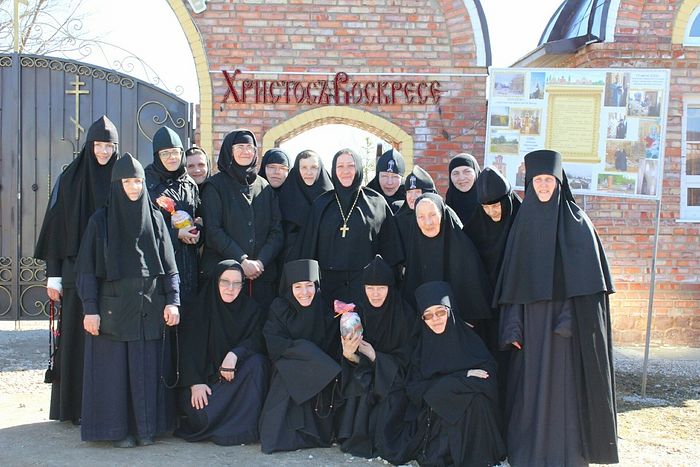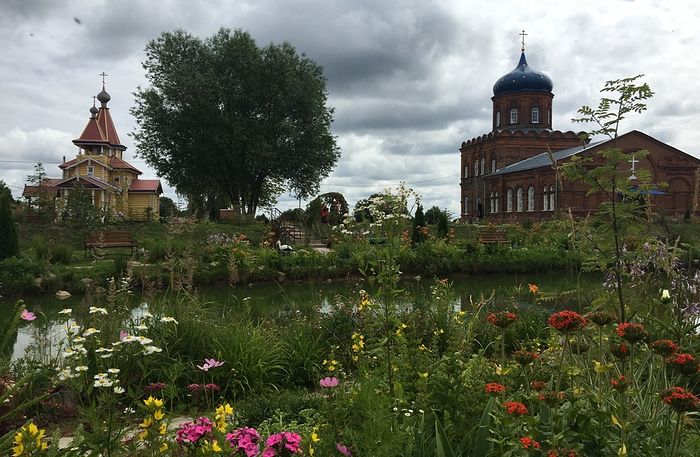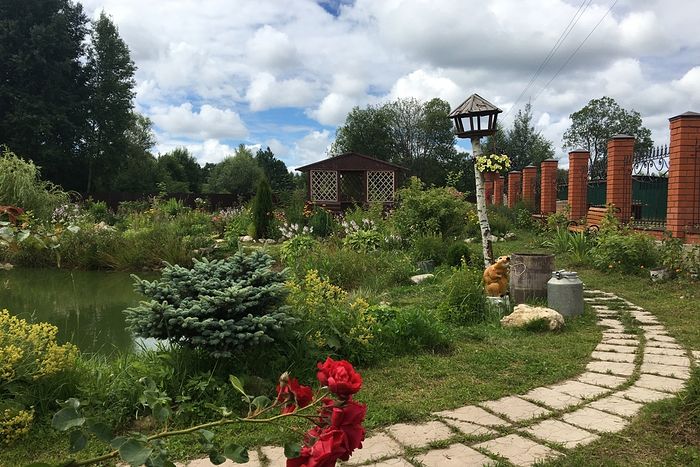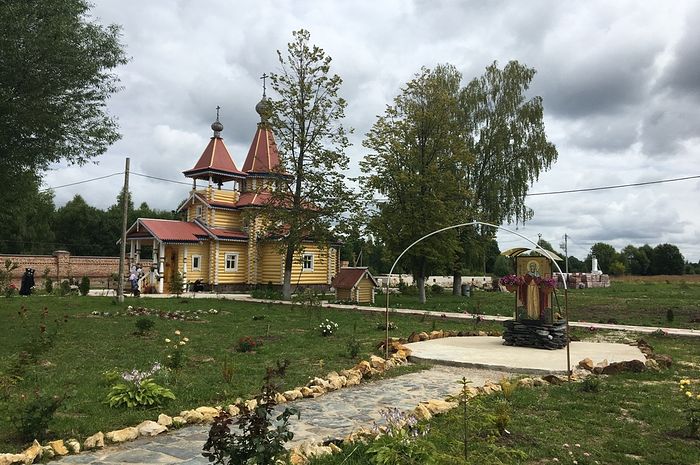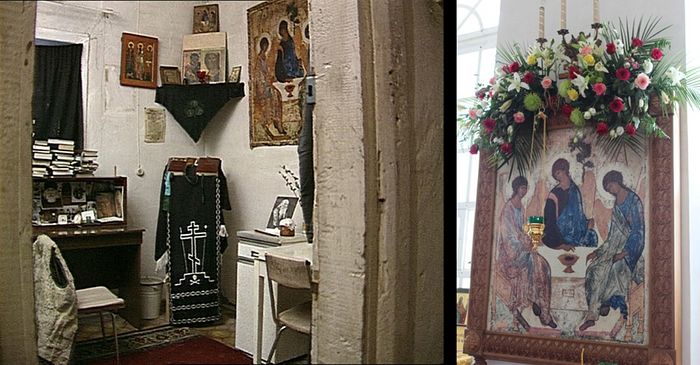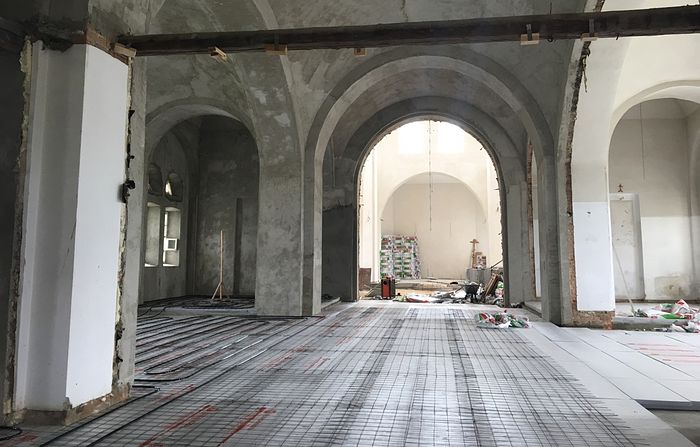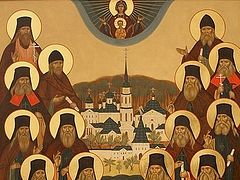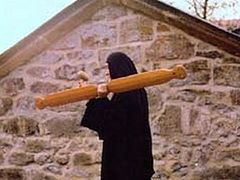On the feast of the “Three Hands” icon of the Holy Theotokos I came to the Convent of St. Thecla and Holy Dormition in the village of Senino [the Kozelsk district of the Kaluga region over 100 miles south of Moscow], where an ancient “Three Hands” icon miraculously renewed itself and became one of the most revered relics of the convent. After praying at a service and looking around the convent and the church that houses over 200 particles of saints’ relics, I was fascinated by the abundant mercy and grace that the Lord has been pouring on this place through the prayers of the nuns and their father confessor.
Abbess Vitalia (Kochetova) has shared wonderful stories with me which can be compared with those from the Lives of Monastic Fathers of old times. I believe all the readers remember from the Lives of the Fathers how one monk was ordered to plant a dry stick in the sand and water it as obedience, which he did until it blossomed. It seems to many of us that such miracles were possible only in the distant past but not today. However, the modern stories of the St. Thecla’s Convent are really miraculous. We offer our readers some of them. Mother Vitalia relates these stories.
***
Pasta with “ketchup”
In 2005, we ended up in the village of Senino some twelve miles away from Optina Monastery. At that time we couldn’t imagine that a convent with forty sisters would grow in this place. That seemed impossible.
It was our father confessor, Igumen (now Archimandrite) Anthony (Gavrilov) from Optina Monastery, who brought two of us here: me, Nun Vitalia, and my companion, Nun Theodora. He dropped us off near an old small house where we were to live and whose previous dwellers had been unemployed alcoholics.
Sister Theodora and I (then both very young nuns) cautiously went inside. But what we saw inside was a sight not for the faint-hearted. It was a very dirty and smoke-filled house with an old stove, iron soldier’s beds with lumpy, shabby mattresses. The smell was so awful that both of us gasped for air (and we suffered from a bad allergy). The faded wall-papers were “quivering” on the walls. Fr. Anthony followed the direction of our glances and remarked cheerfully:
“Good wall-paper!”
Though we were “city girls”, we well realized that we wouldn’t be able to live without water. So we rushed towards a water pump near our hut to discover that its water was rusty.
Fr. Anthony showed us the old, tumbledown church and exhorted us:
“Live here. Pray here, walk in cross processions, and may the Lord help you!”
Thus we remained in Senino. Later on that day we tried to cook macaroni, which came out red because of the rust, as if it were covered with ketchup!
We walked around the village. Two nuns and God-forsaken areas, a strange, dying village. The residents of Senino (before the Revolution called Kosyn) were absolutely non-religious people and met us hostilely. “Why have these nuns come here?” They had long forgotten that their God-fearing great-grandfathers built a huge cathedral for their grandchildren, great-grandchildren, and great-great-grandchildren on the site of the ancient wooden church built in 1686. That cathedral with three altars and a 196-foot bell-tower was constructed on a foundation made of rubble stone and egg whites in the mortar mix. It was built to last.
The marvelous cathedral was closed down in the 1930s, and the “Rodina” (“Homeland”) collective farm was founded in the village. Thereafter cows would often stray inside the abandoned cathedral to rest in the shade and keep cool.
Then the cathedral was converted into a school, a granary, a mechanical repair shop, and then fertilizer storage, and the once hardworking village inhabitants began to ruin their lives by drinking. Soon Senino became notorious for its crimes. Little by little the collective farm went kaput and closed down, and only remains of the burned-out village hall, non-functional granaries, and a run down bathhouse were grim reminders of the villagers’ dreams of “a bright Communist future” that they strove to build without God. In the evenings these structures were used by local alkies and drug addicts for “cultural events” that would often end in tragedy…
Now with the blessing of Metropolitan (then Archbishop) Clement of Kaluga and Borovsk and our father-confessor, Archimandrite (then Igumen) Anthony it was time to restore the church. Walking around the church in a cross procession every evening was our obedience.
On the first evening we asked our father confessor before the procession:
“Father, may we mow down the long grass before praying?”
“You are soldiers of Christ! Go and pray first instead of mowing!” he replied.
When we walked around the church in a cross procession for the first time and then stepped inside, we were met by three white pigeons. While we were singing the troparion, they were hovering under the dome, and when we stopped they flitted out through window openings. And we never saw this miracle again. Of course, we did see bluish, motley and grey pigeons, but not white ones.
And we felt such a joy and bliss during our first procession of the cross, although we didn’t know the reason. After all, we lived in utter desolation. But it was the joy of obedience. And we said to our father confessor:
“Father, we feel so good here!”
It seemed as if the Lord Himself and His Most Pure Mother were embracing us for our intention to settle here, to pray, and bring the church back to life.
So our community was born in 2005: we would arrange cross processions and pray. We also tried to bring young people who liked boozing in the neglecting buildings beside the church to their senses. That was quite terrifying.
There is an old man living in the village close to our convent who used to send us letters with threats after our arrival. He would write at the beginning of each letter: “You have a month to live!”, or “You have a week to live!”, or “You have three days to live!” By those letters we could count how many days of our stay in the area were left.
A community of nuns in honor of the Martyr Thecla
Little by little new sisters joined us. As a father-confessor of Optina Monastery Fr. Anthony saw the women from among our pilgrims who had an inclination towards monastic life and would tell them about our community. Some let it float past their ears (wishing to live in a well-organized community with all conveniences), others stayed for a little while and left, and others remained with us forever.
Work began on the church restoration, and all of us were under our father-confessor’s spiritual guidance. As years went by, our sisterhood grew, and with Fr. Anthony’s blessing we entrusted our community to the heavenly care of the Holy Martyr Thecla.
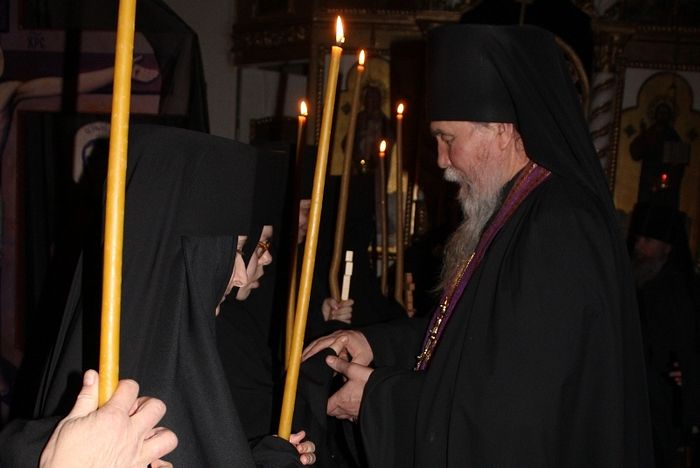 The convent’s father-confessor Archimandrite Anthony (Gavrilov) congratulates the sisters on receiving the monastic tonsure.
The convent’s father-confessor Archimandrite Anthony (Gavrilov) congratulates the sisters on receiving the monastic tonsure.
On coming to our convent pilgrims wonder why it was named in honor of St. Thecla, the Virgin Proto-Martyr who is little-known in Russia. And when we recount the story of this saint to them they wonder why they haven’t known about her before.
A disciple of Apostle Paul, St. Thecla lived in the first century A.D. She possessed the gift of spiritual discernment, the gift of preaching, was an eldress and mentor of a female community, and the faithful flocked to her from far away, seeking her counsel. Through her prayers famine, pestilence and drought stopped; she cast out demons, healed the sick, delivered people from dangers, reconciled couples, consoled the sorrowful. Her prayers were also sought by those with unbelieving relatives and those lacking faith, as she had an ardent faith herself.
The persecutors inflicted numerous torments upon her, but Divine power preserved her unharmed. They tried to burn and drown her, but unsuccessfully; and when they wanted to defile her, a rock split open and hid the virgin. The pagans believed that her clothes were magical as even wild beasts would not touch the saint. St. Thecla is venerated as the first female martyr.
Many female martyrs, such as the Great Martyrs Barbara and Parasceva, invoked the name of St. Thecla while undergoing torments. She is mentioned in all litanies as “the Virgin Proto-Martyr”, and her name is also invoked during the tonsure of women into monasticism.
Temptations abounded. A worker who undertook to do our construction work turned out to be an odd man, to put it mildly. He got drunk and ran after us, threatening to kill us with an axe! We were terrified and called our father confessor, but he didn’t answer. So we nearly lost heart and thought: “Our father has forgotten us.”
But he called us back very quickly and said:
“I am standing and hearing confessions, receiving pilgrims. And I hear the hum of voices from Senino! What has happened with you?”
Fr. Anthony always feels in spirit whatever happens to us. Through his prayers we have managed to survive. It was the same on that day: We asked for his prayers, and the worker threw down his axe, calmed down and forgot that he had threatened us a few minutes earlier.
It should be said that Fr. Anthony is spiritually with us all the time. We have always felt his prayers. Whenever he is unable to visit us (as a monk of Optina) he nevertheless remains with us spiritually.
With Fr. Anthony’s blessing I went to the Pskov Caves Monastery, told Elder Adrian (Kirsanov; 1922-2018) about our life at the convent and about that worker, and asked for his prayers. Fr. Adrian answered, “Yes, this man is capable of killing. You’d better not have any dealings with him at all.”
He added:
“The Mother of God preserves you. The Lord’s blessing is upon this place. There will be a convent there, and I will keep you in my prayers.”
Before I left, Elder Adrian had given me the following instruction: “You should do everything with love. One can labor and keep the fast all day long, yet without love all will be in vain. Whether you work or pray, do it with love.”
The “second youth” of our hens
On the first morning after our arrival to Senino we heard a rooster crowing. We went out to the yard and saw a rooster that looked very happy. It had brought two hens with it. They appeared as if from nowhere. It was amusing to observe the hens walking along the yard side by side. From that day on both of them have provided us with eggs and are good layers.
Then Fr. Elias, manager of the Optina farm, decided to give us their culled hens. He said:
“These are old, sick, culled hens. They don’t lay eggs any more. But, who knows, what if God performs a miracle and they begin to lay eggs again?”
We were glad to receive any gift. But as soon as we saw the hens, they turned out to be bluish, mangy and almost featherless. We were confused, but, remembering the proverb, “don't look a gift horse in the mouth”, thanked Fr. Elias and took them to Senino. And the hens were so pleased with their new life that soon they were covered with feathers again, looked younger and miraculously started to lay eggs.
When we told Fr. Elias about it, he was surprised and amazed. It was a miracle of God for our gratitude.
The bees flew over to us.
Soon our father confessor blessed us to keep bees. But I had a severe bee sting allergy. Once a bad swelling of my hand occurred after a bee sting, it became purple, and I was nearly rushed to a resuscitation unit. So Mother Theodora and I decided not to keep any bees.
One day I was told that we had old beehives in our yard and that some bees had suddenly settled there! So they made our convent their home themselves! And my obedience was to look after these bees and I have had no allergy ever since. What’s more, Elder Adrian from the Pskov Caves Monastery preferred our honey to anybody else’s.
How we obtained a she-goat
One day we were given an old, black female goat. It turned out to be an ill-tempered animal which wouldn’t allow anybody to milk it. We would pray hard, and take ropes and go and catch the goat. We would tie it to the fence and try to milk it, but to no avail: the animal would resist, howling like a wolf and yelping like a fox.
We finally “found a common language” by chance. Once we started singing the prayer, “O Theotokos and Virgin rejoice,” and the goat suddenly calmed down, listening spellbound to us, and we milked it easily.
Thus it became our custom to milk that goat with prayer. In time the animal changed its behavior: it became friendly and so obedient that it seemed as if it understood people’s speech. It was difficult to imagine that once the same goat had howled, yelped, and kicked like a wild animal.
Soon a cat came to live with us. One day it led me to a shed and showed me her three newly-born kittens. So cats have lived with us since then permanently. They make good “guard cats”— they drive stray dogs from the convent’s territory, inform us about the arrival of pilgrims or strangers by mewing, and even accompany the sisters in cross processions.
One day we left a package of cucumbers on the table, but when we came back we didn’t find it. Suddenly we heard somebody crunching. We looked under the table and saw a cat sitting there, devouring our cucumbers with pleasure. Soon the same cat had kittens and taught them its own manners and habits, including cucumber eating. Thus the mother and its litter began to frequent our neighbor granny Nyusha’s kitchen-garden to steal her cucumbers.
The old woman took offence and tried to cut off all her cucumbers from the vine before the cats could do it… But it was easier said than done! The cunning kittens watched for young ripe cucumbers and ate them before the old woman could cut them off. Eventually we had to give the “cucumber-eating” cat and its litter to some pilgrims from a city.
We also had a Saanen goat. It was a big, thoroughbred billy goat which smelled so bad that we called it Funya (meaning “Stinker”). And we also owned a carthorse, a mare named Belka (“White”), which was given to us by the late Archimandrite Benedict, father-superior of Optina Monastery. The mare was aged, and the father superior made the following remark:
“I am giving you this mare so that it can retire on a pension.”
The sisters grew fond of Belka, took great care of it, so that the animal (like other animals of our convent) “got a new lease of life”, began to look younger and served us for several years, carrying construction materials and vegetables from the kitchen-garden.
In those years we had only one shed, so we had to stable the mare together with the billy goat. To our amazement, both of them came to love each other and never parted. Whenever we harnessed Belka, the billy goat ran after it as if it were its beloved colt. If Funya lingered somewhere, Belka would neigh and call it.
Later we acquired nanny goats and a funny story occurred. One morning we led out the goats and the mare at the same time. Then Funya went out of the shed and hesitated: There was his harem of female goats on one side and his beloved “mother” Belka on the other side. The goat stood for some while, looking at both parties closely, then shook its beard and followed the mare! Such a faithful billy goat he was.
Once Funya tagged after our herd of cows. They were displeased, started butting him, and he yelled. Although Belka was pasturing a long way from them, she heard it, walked towards the cows, saved Funya from them, licked him as if he were her colt and led him back home. As for the cows, they hid from Belka in the forest, and it took us a long time to find all of them there.
It would seem that all the stories about our animals are just funny; but if we think deeply about them, it is amazing how the animals are drawn by the holiness of the place and the human prayer. Chickens, bees and cats came to live here themselves…
When Metropolitan Clement of Kaluga and Borovsk was on a visit to our convent he said:
“Your life is like Paradise. All kinds of animals live with you…”
We looked around us and came to realize that the life of our animals indeed resembled life in Paradise. Grass snakes have settled into two ponds that we dug. They enjoy swimming there. A lot of grass snakes also live in our greenhouses and breed there; we are not afraid of them as they are harmless. According to biologists, you will find no mice in areas where hedgehogs thrive, and you will find no slugs where frogs and toads are plentiful. But here all of them somehow get along with each other.
Once an old log house was delivered to us, and vipers began to multiply here immediately. We were totally displeased with these neighbors. At that time we were on a pilgrimage to the Pskov Caves Monastery. When we told Elder Adrian about the adders, he gave us this short answer:
“Witchcraft.”
The elder blessed us to hold a prayer service to Sts. Cyprian and Justina. Our father-confessor Archimandrite Anthony came, performed a prayer service, sprinkled the area with holy water, and all the vipers vanished at once (we have not seen a single viper since then). As for the old log house, we burned it down.
Although Elder Adrian never visited Senino, he used to say that this place was severely desecrated. It seemed as if he saw everything with his very eyes. Indeed the church altar and the bell-tower had been blown up, and ammonia fertilizer lay right in the central aisle. We removed this fertilizer on trucks. After the first stage, the ammonia concentrations were as many as thirty-seven times higher than allowable, so we continued cleaning, washing walls, and partly replacing bricks.
We also approached the locals:
“Let’s resurrect the church together!”
“No, thanks. We don’t need it!”
But one day I finally persuaded a few people to help us. They worked on our territory a little. I was so happy and said:
“Thank you! May God save you!”
And they replied:
“Don’t thank us! Give us money!”
Sometimes I would begin to grumble and complain to my spiritual father:
“Father, there are no resources! I have no strength!”
And he would answer:
“God has an abundance of all things! Pray and He will send you all that you need!”
Fr. Anthony often repeats that we are unable to do anything by ourselves. Everything is done with the help of God.
And at last we have our first benefactors. Such people appear in our lives when we pray a lot. First and foremost, our father-confessor Archimandrite Anthony, Elder Adrian, and Schema-Archimandrite Iliy (Nozdrin) prayed for us. We have seen the words “God has an abundance of all things” work in practice. We realized that God Himself is building the convent, and we just need to obey Him.
100 sisters
Like Elder Adrian, Elder Iliy predicted that there would be a convent in this place. It was hard for us to believe it back then. Fr. Iliy still asks me when we meet:
“Have you already gathered 100 sisters in your community?”
“Father, I cannot imagine 100 nuns! May God give me strength to manage the forty sisters that I currently have.”
“Not forty! Your sisterhood will have 100 nuns!”
Little by little the locals became very friendly to us. Many of them have changed: they now attend our church and many were baptized. The Lord softens people’s hearts. Of those who met us with animosity at the very beginning only a few are still here; some have died, others moved to other places.
Now even young people go to our church, especially on major feasts, and participate in Holy Unction services. And the environment around us has changed. Even the head of the local administration said:
“Imagine that! The village has been completely transformed!”
A hospice (almshouse) opened at our convent soon after it was founded. There were people who needed our care, and our father confessor taught us to regard serving our neighbors as our first priority. When God allows you to take care of somebody, to serve the sick, it is, above all, His mercy upon you.
Several nuns were admitted to our hospice: the first one was blind, the second one was bedridden, the third one was with cancer, the fourth was aged and sickly, the fifth came after a stroke. The number of those who needed our care grew. Now there are ten of them.
We took one of the nuns from Kozelsk. She was a stroke survivor with dementia. When I arrived at her apartment the door was wide open, the apartment itself was empty (everything, including her documents, had been stolen); there was stale bread and rotten fish. The nun could remember nothing. Somebody from the Department for Social Protection called on her occasionally, but those infrequent visits were not enough.
We took that nun into our care. The sisters took care of her for two years and she frequently took Communion. And we buried her after her death. Before her repose she received Unction and Communion, and the Psalter was read at her bedside permanently.
That nun passed away on the feast of the Great Martyr Barbara. Interestingly, the first service to be celebrated at our church after its desecration had also been on the feast of the Great Martyr Barbara. So we especially pray to this saint and consider her as our co-patroness.
The convent as a miracle of obedience
Our convent is a miracle of our obedience to our father confessor Archimandrite Anthony. It sprang up from scratch. Two young sisters came to a village in the middle of nowhere. Now a well-established convent functions here, which has numerous holy relics and as many as forty nuns.
Our father confessor instructs us:
“Now your main task is to bear one another’s burdens and forgive each other.”
He is right. And that is a very difficult task. Different people come to the convent—some are young, others are elderly, and all have their deep-rooted habits. It is easy to indulge in fantasies, imagining yourself as a great faster and a woman of prayer, yet it is so hard to bear somebody else’s weaknesses, to humble yourself before your neighbor, to cut off your own will, and to forgive each other.
Recently workers from a ferroconcrete plant in the town of Kirov of the Kaluga region were at our convent. Though they are not religious people, they nevertheless sensed the grace of this place. As they walked around the convent, they were smiling and rejoicing. They said the same words that we had uttered some years before them:
“Oh, we feel so good here!”
“And what exactly do you like here?”
“We don’t know. We cannot explain it properly. But the atmosphere here is fantastic!”
The Church of the Virgin Proto-Martyr Thecla
We have built the first Church of the Equal-to-the-Apostles Martyr Thecla in Russia. It was consecrated by Bishop Nikita of Kozelsk and Lyutinovo in 2016. This beautiful wooden church is in the Russian architectural style. It houses a particle of the hand of the Virgin Proto-Martyr Thecla along with two icons with particles of her holy relics. Our patronal feast is celebrated on October 7.
In 2009, the rector of the Bulgarian Metochion in Moscow gave us an old icon that was so worn and faded that its image was indiscernible. A little later it was clear that it was an image of the Mother of God. And finally we were able to discern that it was the “Three Hands” icon. Within a half a year the icon renewed itself without any restoration work; and the Theotokos works countless miracles (including those of healing) through this holy image. And it was thanks to this wonderworking icon that my heart surgery was cancelled, too.
Another highly revered relic of our convent is the icon of the Mother of God “Assuage My Sorrows”. On January 20, 2010, it started exhaling myrrh for the first time. It exuded myrrh again on important days of our history, for example, before the opening of our convent.
We possess one more unique treasure, namely an icon of the Holy Trinity that was a private icon of Hieromonk Vasily (Roslyakov), who was martyred in Optina Monastery on Pascha Sunday, 1993.
Enumerable miracles occur through St. Thecla’s intercessions. We make small prayer belts and have them blessed on the icon of St. Thecla with a particle of her relics; and prayers to this saint work numerous miracles and cures. In some cases barren couples were able to miraculously conceive a child. The faithful can order an Akathist hymn to the Virgin Martyr Thecla, which we read for forty days for their health and needs of various kinds. Some people phone us afterwards and share their miraculous stories of healing or deliverance from difficult life situations.
Here is one of the latest testimonies. In 2017, we received one pilgrim whose daughter was infertile. We gave her one of our belts blessed on the saint’s icon with her holy relics. And lo and behold, her daughter gave birth to twins in the same year! Remarkably, the twins are jokingly called, “Thecla’s children”.
We are more than happy to have guests and pilgrims. You are always welcome!
A lot of work needs to be done at our convent, so we ask you to support us by making donations. We want to completely restore our Holy Dormition Church, and we also need funds to maintain our hospice and to take care of our sick and elderly nuns. We will assuredly pray in front of our most revered icons for all who can make a modest donation for the glory of God.
May the Lord keep you, our beloved brothers and sisters!
To be continued.
Details for donations:
Recipient: Религиозная организация «Женский монастырь ‟Успенская Феклина
женская пустынь” села Сенино Козельского района Козельской Епархии Русской
Православной Церкви (Московский Патриархат)» (the religious organization “The Convent of St. Thecla and the Dormition of the Senino village of the Kozelsk district of the Diocese of Kozelsk of the Russian Orthodox Church of the Moscow Patriarchate”).
The recipient’s bank: Калужское отделение №8608 ПАО Сбербанк
The recipient’s bank identification code: 042908612
Correspondent account: №30101810100000000612
Recipient’s settlement account: №40703810422240000226
Taxpayer identification number: 4001009959 КПП 400101001
Transfer to bank card:
5469 2200 1232 9121 Сбербанк Кочетова Валентина Анатольевна (Sberbank of Russia, Kochetova Valentina Anatolievna)
Telephones: +7‒910‒542‒41‒43; +7‒962‒370‒04‒50.
The convent’s website: Fekla-mon.ru
Postal address: 249731, 40 Tsentralnaya Ulitza, Derevnya Senino-Pervoye, Kozelskiy Rayon, Kaluzhskaya Oblast, Russia.

